Launch date 2020 | ||
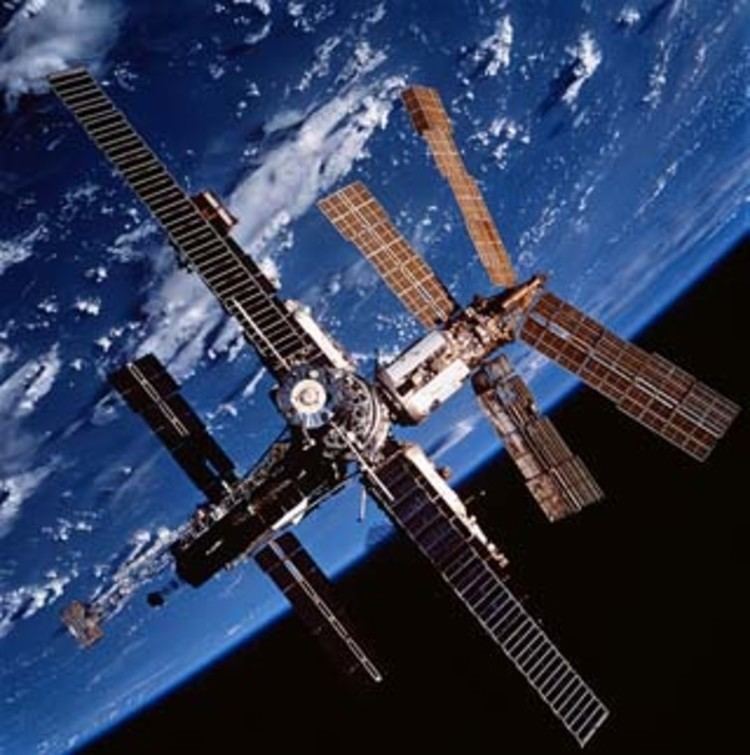 | ||
Similar Tiangong‑1, Tiangong‑2, Tianzhou, Shenzhou, Chang'e 2 | ||
The Chinese large modular space station, is a planned space station to be placed in Low Earth orbit. The planned Chinese Space Station will be roughly one-sixth the mass of the International Space Station and half the size of the decommissioned Russian Mir Space Station. The Chinese station is expected to have a mass between 60 and 70 metric tons. Operations will be controlled from the Beijing Aerospace Command and Control Center in China. The planned launching date of the core module, the Tianhe-1 (“Harmony of the Heavens”), is around 2018. In 2017, the Chinese will launch the Tianzhou-1 ("Heavenly Vessel") cargo spaceship, which is based on the Tiangong 1 & 2 space laboratories.
Contents
- Purpose
- Precursor projects
- Precursor space stations
- Tiangong 1 target vehicle
- Tiangong 2 space laboratory
- Tiangong 3 space station
- Naming the CSS
- Structure
- Technology exchanges
- Modules
- Construction
- Electrical
- Docking
- Experiments
- Resupply
- Shenzhou
- Tianzhou
- Orbital debris
- Radiation
- International co operation
- End of orbit
- References
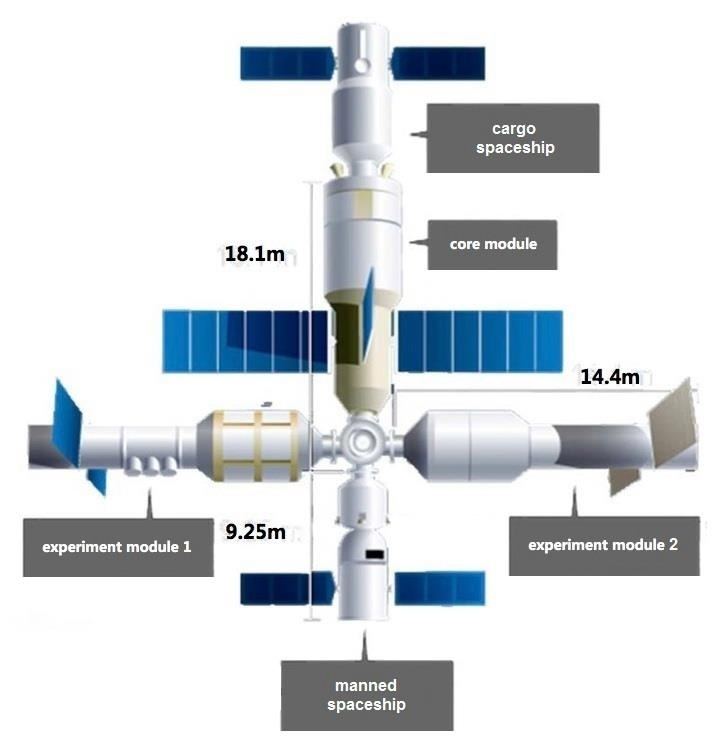
Purpose
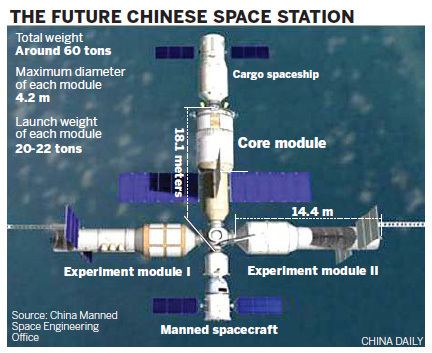
China seeks to enhance the capacity of its scientific and technological capacity. Chinese leaders hope that research conducted on the station will improve researchers' ability to conduct science experiments in space, beyond the duration offered by China's existing space laboratories.
Precursor projects
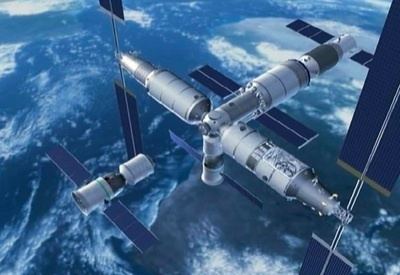
After the United States threatened to use nuclear weapons during the Korean War, Chairman Mao Zedong decided that only a nuclear deterrent of its own would guarantee the security of the newly founded PRC. Thus, Mao announced his decision to develop China's own strategic weapons, including associated missiles. After the launch of mankind's first artificial satellite, Sputnik 1 by the Soviet Union on 4 October 1957, Chairman Mao decided to put China on an equal footing with the superpowers ("我们也要搞人造卫星"), using Project 581 with the idea of putting a satellite in orbit by 1959 to celebrate the 10th anniversary of the PRC's founding.
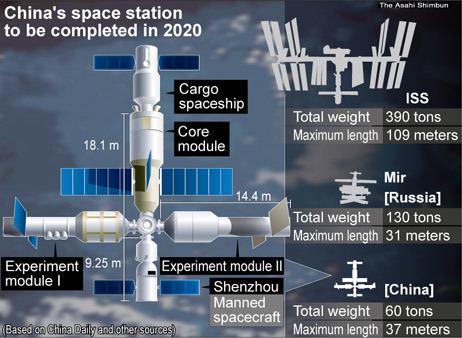
Mao and Zhou Enlai began the PRCs crewed space program on 14 July 1967. China's first manned spacecraft design was named Shuguang-1 (曙光一号) in January 1968. Project 714 was officially adopted in April 1971 with the goal of sending two astronauts into space by 1973 aboard the Shuguang spacecraft. The first screening process for astronauts had already ended on 15 March 1971, with 19 astronauts chosen. The program was soon cancelled due to political turmoil.
The next crewed space program was even more ambitious and was proposed in March 1986 as Project 863. This consisted of a crewed spacecraft (Project 863-204) used to ferry astronaut crews to a space station (Project 863-205). Several spaceplane designs were rejected two years later and a simpler space capsule was chosen instead. Although the project did not achieve its goals, it would ultimately become the 1992 Project 921, encompassing the Shenzhou program, the Tiangong program, and the CSS.
On the 50th anniversary of the PRC's founding, China launched the Shenzhou 1 spacecraft on 20 November 1999 and recovered it after a flight of 21 hours. The country became the third country with a successful crewed space program by sending Yang Liwei into space aboard Shenzhou 5 on October 15, 2003 for more than 21 hours. It was a major success for Chinese space programmes.
Precursor space stations
In Project 921, three space stations of varying sophistication and each testing and improving systems required for the CSS.
Tiangong 1 "target vehicle"
Originally, China planned to simply dock Shenzhou 8 and Shenzhou 9 together to form a simple space laboratory. However, it was decided to abandon that plan and launch a small space laboratory instead. In 2007, plans for a "space laboratory", Tiangong 1 were announced. Subsequent flights (Shenzhou 9 and Shenzhou 10) would dock with the laboratory. Tiangong 1 consisted of a propulsion module, and a pressurised module for experiments. The Chinese space agency incorrectly stated that Tiangong 1 had a docking port at both ends. The docking port of the experiment section supported automated docking. Launched on September 29, 2011, it was intended for short stays of a crew of three. The second docking port, on the propulsion module, was kept screened from press photography inside and outside the module. It is expected to re-enter and burn up in the atmosphere late 2017.
Tiangong 2 "space laboratory"
The Chinese Space Lab Tiangong 2 was launched on 15 September 2016.
Tiangong 3 "space station"
Tiangong 3, to be launched in the 2020s, will provide 40 days of life support for a crew of three. It shall be used to evaluate regenerative life support technology, and verify orbital replenishment of propellant and air, similar in function to the Russian Elektron system used on Mir and the ISS.
Naming the CSS
The paramount leader of the People's Republic of China from 1978 to 1992, Deng Xiaoping, changed the cultural fabric of the Chinese society and decided names used in the space program, previously all chosen from the revolutionary history of the PRC, would be replaced with mystical-religious ones. Thus, new Long March carrier rockets were renamed Divine arrow (神箭), spacecapsule Divine vessel (神舟), space shuttle Divine dragon (神龙), land-based high-power laser Divine light (神光) and supercomputer Divine might (神威).
These poetic names continue as the first, second, third, fourth and fifth Chinese Lunar probes are called Chang'e after the Moon goddess. The name "Tiangong" means "heavenly palace". Across the PRC the launch of Tiangong 1 inspired a variety of feelings, including love poetry. Within the PRC, the rendezvous of space vehicles is compared to the reunion of the cowherd and the weavergirl, Niulang Chinese: 牛郎 and Zhinü Chinese: 織女, lovers separated by the Milky Way which was scratched there by an angry goddess. Only on the night of sevens, over a bridge made from all of the sympathetic magpies in the world, the lovers may meet. The remainder of the year, Zhinü sits on the banks of the 'Milky Way' river with two of her children and weaves the clouds, with Niulang on the other side.
Wang Wenbao, director of the CMSE, told a news conference in 2011 "Considering past achievements and the bright future, we feel the manned space programme should have a more vivid symbol, and that the future space station should carry a resounding and encouraging name. We now feel that the public should be involved in the names and symbols, as this major project will enhance national prestige and strengthen the national sense of cohesion and pride." Imagery of the Chinese space program has been used by the Party (government) to strengthen its position and promote patriotism since the late 1950s and early 1960s.
On October 31, 2013, China Manned Space Engineering announced the new names for the whole program:
Structure
The CSS will be a third generation, modular space station. First generation space stations, such as early Salyut (fireworks), Almaz (diamond), and Skylab, were single piece stations and not designed for resupply. Second generation Salyut 6 and 7, and Tiangong 1 and 2 stations, are designed for mid-mission resupply. Third generation stations such as Mir, the International Space Station, OPSEK and the CSS are modular space stations, assembled on-orbit from pieces launched separately. Modularised design methods can greatly improve reliability, reduce costs, shorten development cycle, and meet diversified task requirements.
Technology exchanges
The assembly method of the station can be compared with the Soviet-Russian Mir space station and the Russian orbital segment of the International space station, if the station is constructed, China will be the second nation to develop and use automatic rendezvous and docking for modular space station construction. Shenzhou spacecraft and space stations use a domestically made docking mechanism similar to, or compatible with, the Russian designed APAS docking adapter.
During the cordial Sino-Soviet relations of the 1950s, the USSR engaged in a cooperative technology transfer program with the PRC under which they taught Chinese students and provided the fledgling program with a sample R-2 rocket.
The first Chinese missile was built in 1958 reverse-engineered from the Soviet R-2, itself an upgraded version of the German V-2 rocket. But when Soviet premier Nikita Khrushchev was denounced as revisionist by Mao, the friendly relationship between the two countries turned to confrontation. As a consequence, all Soviet technological assistance was abruptly withdrawn after the 1960 Sino-Soviet split.
Development of the Long March rocket series allowed the PRC to initiate a commercial launch program in 1985, which has since launched over 30 foreign satellites, primarily for European and Asian interests.
In 1994, Russia sold some of its advanced aviation and space technology to the Chinese. In 1995 a deal was signed between the two countries for the transfer of Russian Soyuz spacecraft technology to China. Included in the agreement was training, provision of Soyuz capsules, life support systems, docking systems, and space suits. In 1996 two Chinese astronauts, Wu Jie and Li Qinglong, began training at the Yuri Gagarin Cosmonaut Training Centre in Russia. After training, these men returned to China and proceeded to train other Chinese astronauts at sites near Beijing and Jiuquan. The hardware and information sold by the Russians led to modifications of the original Phase One spacecraft, eventually called Shenzhou, which loosely translated means "divine vessel." New launch facilities were built at the Jiuquan launch site in Inner Mongolia, and in the spring of 1998 a mock-up of the Long March 2F launch vehicle with Shenzhou spacecraft was rolled out for integration and facility tests.
A representative of the Chinese manned space program stated that around 2000, China and Russia were engaged in technological exchanges regarding the development of a docking mechanism. Deputy Chief Designer, Huang Weifen, stated that near the end of 2009, the Chinese agency began to train astronauts on how to dock spacecraft.
Modules
The Core Cabin Module provides life support and living quarters for three crew members, and provides guidance, navigation, and orientation control for the station. The module also provides the station’s power, propulsion, and life support systems. The module consists of three sections, living quarters, service section and a docking hub.
The living quarters will contain a kitchen and toilet, fire control equipment, atmospheric processing and control equipment, computers, scientific apparatus, communications equipment to see and hear ground control in Beijing, and other equipment.
The first of two Laboratory Cabin Modules will provide additional navigation avionics, propulsion and orientation control as backup functions for the CCM. Both LCMs will provide a pressurised environment for researchers to conduct science experiments in freefall or microgravity which could not be conducted on Earth for more than a few minutes. Experiments can also be placed on the outside of the modules for exposure to the space environment, cosmic rays, vacuum, and solar winds.
Like Mir and the Russian orbital segment of the ISS, the CSS modules will be fully assembled in orbit, in contrast to the US Orbital Segment of the ISS, which required spacewalking to interconnect cables, piping, and structural elements manually. The axial port of the LCMs will be fitted with rendezvous equipment and will first dock to the axial port of the CCM. A mechanical arm similar to the Russian Lyappa arm used on the Mir space station will then move the module to a radial port of the CCM.
Construction
The space station's core module is set to be placed in 2018, followed by the first laboratory module in 2020, and a second in 2022.
Electrical
Electrical power is provided by two steerable solar power arrays on each module, which use photovoltaic cells to convert sunlight into electricity. Energy is stored to power the station when it passes into the Earth's shadow. Resupply ships will replenish fuel for the station's propulsion engines for station keeping, to counter the effects of atmospheric drag.
Docking
Foreign sources have stated that the docking mechanism strongly resembles APAS-89/APAS-95, with one American source going as far as to call it a clone. There have been contradictory claims on the compatibility of the Chinese system with both current and future docking mechanisms on the ISS.
Experiments
The programmed experiment equipment for the three modules as of June 2016 are:
Resupply
The station will be resupplied by manned spacecraft and robot cargo ships.
Shenzhou
The Shenzhou is designed primarily to carry crew into orbit. It consists of three modules: a forward orbital module (轨道舱), used by crew as working and living space; a reentry module (返回舱) in the middle, which removes all unnecessary equipment making the simplest and thereby safest return to earth; and an aft service module (推进舱), which contains engines, propellants, guidance and orientation control, and cooling. Anything placed in the orbital or service modules does not require heat shielding, and this increases the space available in the spacecraft without increasing weight as much as it would if those modules were also able to withstand reentry. Thus both Soyuz and Shenzhou have more living area with less weight than the Apollo CSM. The mass of the ship is around 8,000 kilograms (8.0 t; 18,000 lb; 8.8 short tons), and it is 9.25 metres (30.3 ft) long. The maximum diameter of the modules is 2.80 metres (9 ft 2 in). With solar panels extended, the station is 17.00 metres (55.77 ft) across.
Until Shenzhou 8, the orbital module of the Shenzhou was equipped with its own propulsion, solar power, and control systems, allowing autonomous flight. It was possible for Shenzhou to leave an orbital module in orbit for redocking with a later spacecraft, something which the Soyuz cannot do, since the only hatch between orbital and reentry modules is a part of reentry module, and the orbital module is depressurised after separation. In the future it might be possible for the orbital module(s) to be left attached to the station as additional station modules. Small modules for the ISS are launched by Soyuz spacecraft in this way. In unmanned test flights, the orbital module of each Shenzhou was left functioning on orbit for several days after the return of the reentry modules, and the Shenzhou 5 orbital module continued to operate for six months after launch.
Tianzhou
Tianzhou (Heavenly Vessel), a modified derivative of the Tiangong-1 spacecraft, will be used as robotic cargo spacecraft to resupply this station. The launch mass of Tianzhou is expected to be around 13,000 kg with a payload of around 6,000 kg. Launch, rendezvous and docking shall be fully autonomous, with mission control and crew used in override or monitoring roles. This system becomes very reliable with standardizations that provide significant cost benefits in repetitive routine operations. An automated approach could allow assembly of modules orbiting other worlds prior to manned missions.
Orbital debris
The CSS will be operated in Low Earth Orbit, 340 to 450 kilometers above the Earth at an orbital inclination of 42 to 43 degrees, in the centre of the Earth's thermosphere. At this altitude there is a variety of space debris, consisting of many different objects including entire spent rocket stages, dead satellites, explosion fragments—including materials from anti-satellite weapon tests (2007 Chinese anti-satellite missile test), paint flakes, slag from solid rocket motors, coolant released by RORSAT nuclear powered satellites and some of the 750,000,000 small needles from the American military Project West Ford. These objects, in addition to natural micrometeoroids, are a significant threat. Large objects could destroy the station, but are less of a threat as their orbits can be predicted. Objects too small to be detected by optical and radar instruments, from approximately 1 cm down to microscopic size, number in the trillions. Despite their small size, some of these objects are still a threat because of their kinetic energy and direction in relation to the station. Spacesuits of spacewalking crew could puncture, causing exposure to vacuum.
Space debris objects are tracked remotely from the ground, and the station crew can be notified. This allows for a Debris Avoidance Manoeuvre (DAM) to be conducted, which uses thrusters on station to change orbital velocity and altitude, avoiding the debris. DAMs will take place if computational models show the debris will approach within a certain threat distance. Usually the orbit will be raised saving fuel, as the station's orbit must be boosted periodically to counter the effects of atmospheric drag. If a threat from orbital debris is identified too late for a DAM to be safely conducted, the station crew close all the hatches aboard the station and retreat into their Shenzhou spacecraft, so that they would be able to evacuate in the event it was damaged by the debris. Micrometeorite shielding is incorporated into the station to protect pressurised sections and critical systems. The type and thickness of these panels varies depending upon their predicted exposure to damage.
Radiation
Stations in low earth orbit are partially protected from the space environment by the Earth's magnetic field. From an average distance of about 70,000 km, depending on Solar activity, the magnetosphere begins to deflect solar wind around the Earth and space stations in orbit. However, solar flares are still a hazard to the crew, who may receive only a few minutes warning. The crew of the ISS took shelter as a precaution in 2005 in a more heavily shielded part of that station designed for this purpose during the initial 'proton storm' of an X-3 class solar flare. But without the limited protection of the Earth's magnetosphere, China's planned manned mission to Mars is especially at risk.
Subatomic charged particles, primarily protons from cosmic rays and solar wind, are normally absorbed by the earths atmosphere, when they interact in sufficient quantity their effect becomes visible to the naked eye in a phenomenon called an aurora. Without the protection of the Earth's atmosphere, which absorbs this radiation, station crews are exposed to about 1 millisievert each day, which is about the same as someone would get in a year on Earth, from natural sources. This results in a higher risk of crew members developing cancer. Radiation can penetrate living tissue and damage DNA, cause damage to the chromosomes of lymphocytes. These cells are central to the immune system and so any damage to them could contribute to the lowered immunity experienced by crew. Radiation has also been linked to a higher incidence of cataracts in astronauts. Protective shielding and protective drugs may lower the risks to an acceptable level.
The radiation levels experienced on ISS are about 5 times greater than those experienced by airline passengers and crew. The Earth's electromagnetic field provides almost the same level of protection against solar and other radiation in low Earth orbit as in the stratosphere. Airline passengers, however, experience this level of radiation for no more than 15 hours for the longest intercontinental flights. For example, on a 12-hour flight an airline passenger would experience 0.1 millisievert of radiation, or a rate of 0.2 millisieverts per day; only 1/5 the rate experienced by an astronaut in LEO.
International co-operation
Cooperation in the field of manned space flight between the CMSEO and the Italian Space Agency was examined in 2011, participation in the development of China manned space stations and cooperation with China in the fields such as astronauts flight, and scientific research was discussed. Potential areas and ways for future cooperation in the fields of development of manned space station, space medicine and space science have also been discussed during the meeting.
End of orbit
The station will have a service life of ten years. Chinese manned spacecraft use deorbital burns to slow their velocity, resulting in their re-entry to the Earth's atmosphere. Vehicles carrying a crew have a heat shield which prevents the vehicle's destruction caused by aerodynamic heating upon contact with the Earth's atmosphere. The CSS has no heat-shield, however small parts of space stations can reach the surface of the Earth, so uninhabited areas will be targeted for de-orbit manoeuvres.
